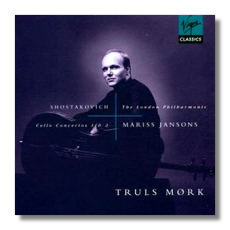
The Internet's Premier Classical Music Source
Related Links
- Shostakovich Reviews
- Latest Reviews
- More Reviews
-
By Composer
-
Collections
DVD & Blu-ray
Books
Concert Reviews
Articles/Interviews
Software
Audio
Search Amazon
Recommended Links
Site News
 CD Review
CD Review
Dmitri Shostakovich

Concertos for Cello
- Concerto #1 in E Flat Major, Op. 107 (1959)
- Concerto #2, Op. 126 (1966)
Truls Mørk, cello
London Philharmonic Orchestra/Mariss Jansons
Virgin Classics 5451452
Thirty seconds into this first cello concerto and you realize you're in for a stunning, dizzying ride, more thrilling than your memories of the meanest Tilt-a-Whirl. Although the specter of cellist Mstislav Rostropovich and conductor Maxim Shostakovich forever hangs over these pieces, cellist Truls Mørk and conductor Mariss Jansons provide a stirring rendition that moves and excites. Mørk dazzles with leaping crescendos in the first movement, while subtly stressing the nuances of the moderato. According to musicologist Ian MacDonald, who searches for secret codes in Shostakovich's works, the Cello Concerto #1 was inspired by the imbroglio over Boris Pasternak's winning the Nobel Prize a year earlier. Shostakovich wanted to create a piece whose exultant defiance and sour melancholy sent a chilling message to the world. Alas, we'll never know for sure. But the pathos in this piece strikes the heart like a parting lover's kiss - so intense it is almost visible. The silences just before the cadenza are terrifying.
Cello Concerto #2, a 1966 composition, has a wan, pained aura, much like a photograph of Shostakovich from that era. This is understandable, since he composed it while recovering in a sanitarium. Mørk and Jansons render this piece less urgently than others have, preferring to draw out the tension. Perhaps rightfully, Jansons wants listeners to taste the individual notes. This is apparent several times in the Scherzo when the horn notes chug downhill like cold honey. This unorthodox tempo takes a little getting used to, particularly because it is not consistent throughout the piece. However, Jansons' interpretation is always startling, and even when it is most quirky, such as in the Finale (those creepy final bars!), it delivers a palpable wallop. This version is worth having, particularly to experience Mørk's sweet legatos, his precision and warmth, his feel for lyricism.
Copyright © 1997, Peter Bates


















